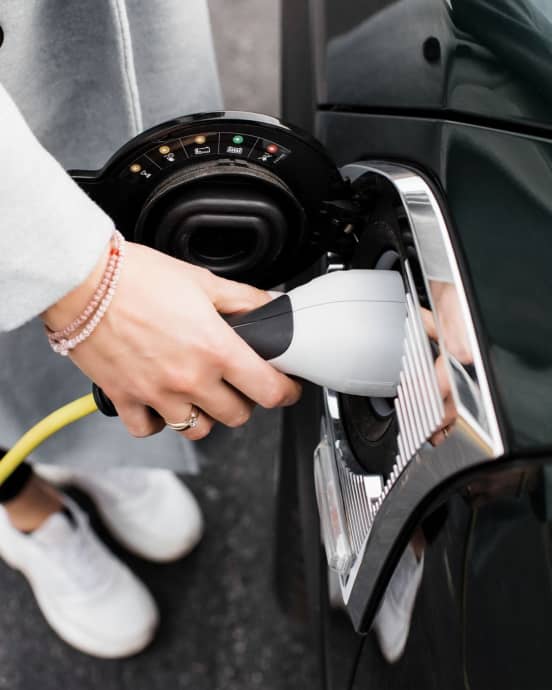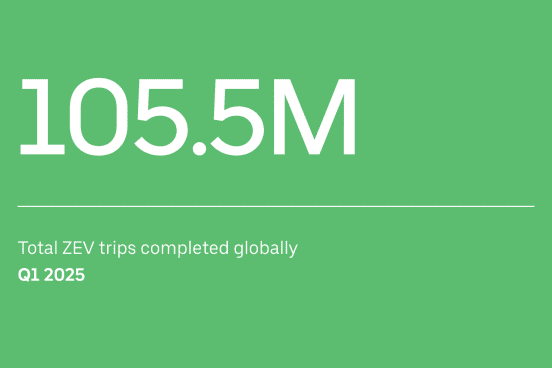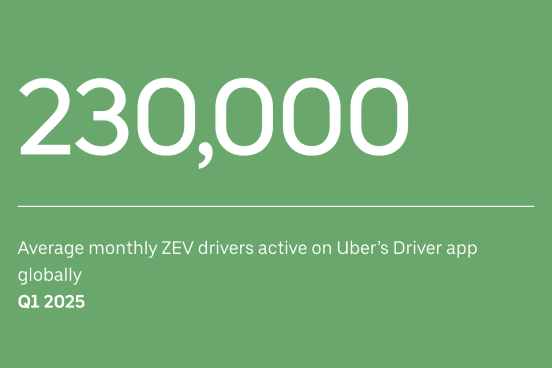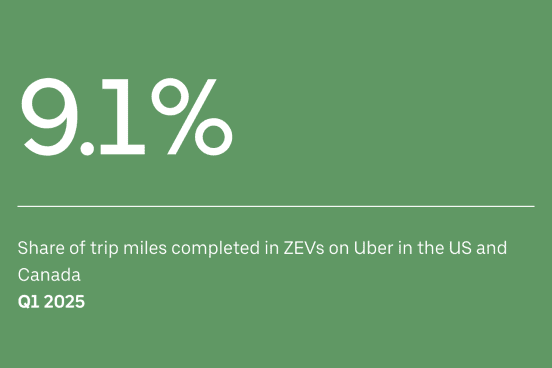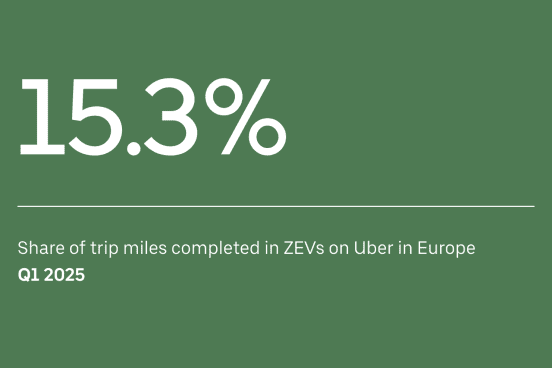Uber’s Electrification Update
"Our ambitious efforts to transition to a zero-emission mobility platform have seen meaningful progress. Today, Uber is the world’s most widely available platform for zero-emission rides, with drivers adopting EVs up to 5 times faster than average motorists in the US, Canada, and Europe."
Rebecca Tinucci, Global Head of Electrification and Sustainability, Uber
Q1 2025 Update: This page includes metrics for trips completed on Uber by internal combustion engine (ICE) vehicles and zero-emission vehicles (ZEVs, such as battery EVs) from the beginning of the first quarter of 2021 to the end of the first quarter of 2025. Note that the scope of this report includes only Uber’s Mobility business (ridesharing).
Tracking our journey to zero emissions
Five years into our ambitious effort to transition to a zero-emission platform, we’ve made meaningful progress. Today, Uber is the world's most widely available platform for zero-emission rides, with drivers adopting EVs (electric vehicles) up to 5 times faster than average motorists in the US, Canada, and Europe.
We’ve invested hundreds of millions of dollars to help interested drivers make the switch to electric through incentives, partnerships, and product enhancements—and it’s paying off. Increasingly, riders are experiencing their first EV on Uber, helping to normalize and accelerate the adoption of electric transport all over the world.
Our data shows that EV progress quickens when government and industry work together to get the economics right. In cities like London, Vancouver, and Amsterdam, where thoughtful policies, industry investment, and strong charging networks align, more than 1 in every 3 miles on Uber are now electric.
Despite this significant progress, major barriers remain to fully achieve our goals. High upfront EV costs, limited charging access, and inconsistent policy support continue to slow adoption. Based on current trends, we cannot meet our remaining mobility and delivery goals for 2025, and our 2030 goals will be out of reach without stronger, coordinated action across government and industry.
As we’ve said from the start: climate is a team sport, and progress depends on collective action. That’s why we’re increasingly prioritizing efforts in cities where public and private investment are aligned.
While many key levers are outside our control, we remain deeply committed to this transition—not just because it’s the right thing to do, but also because it brings direct and strategic business benefits. Thousands of drivers around the world are taking home more money thanks to lower EV operating costs and rider demand for electric vehicles. Riders report higher satisfaction with the EV experience and are increasingly choosing EVs.
And finally, the future is shared, electric, and autonomous—and the coming wave of autonomous (electric) vehicles will create a major tailwind in achieving our sustainability goals.
Our latest update below outlines the progress to date, key insights, and areas of focus for 2025 and beyond.
__
Rebecca Tinucci, Global Head of Electrification and Sustainability, Uber
May 7, 2025
Řidiči ZEV
Globally, more than 230,000 ZEV drivers were active on Uber’s app in Q1 2025. That’s over 60% more than the same period a year earlier.
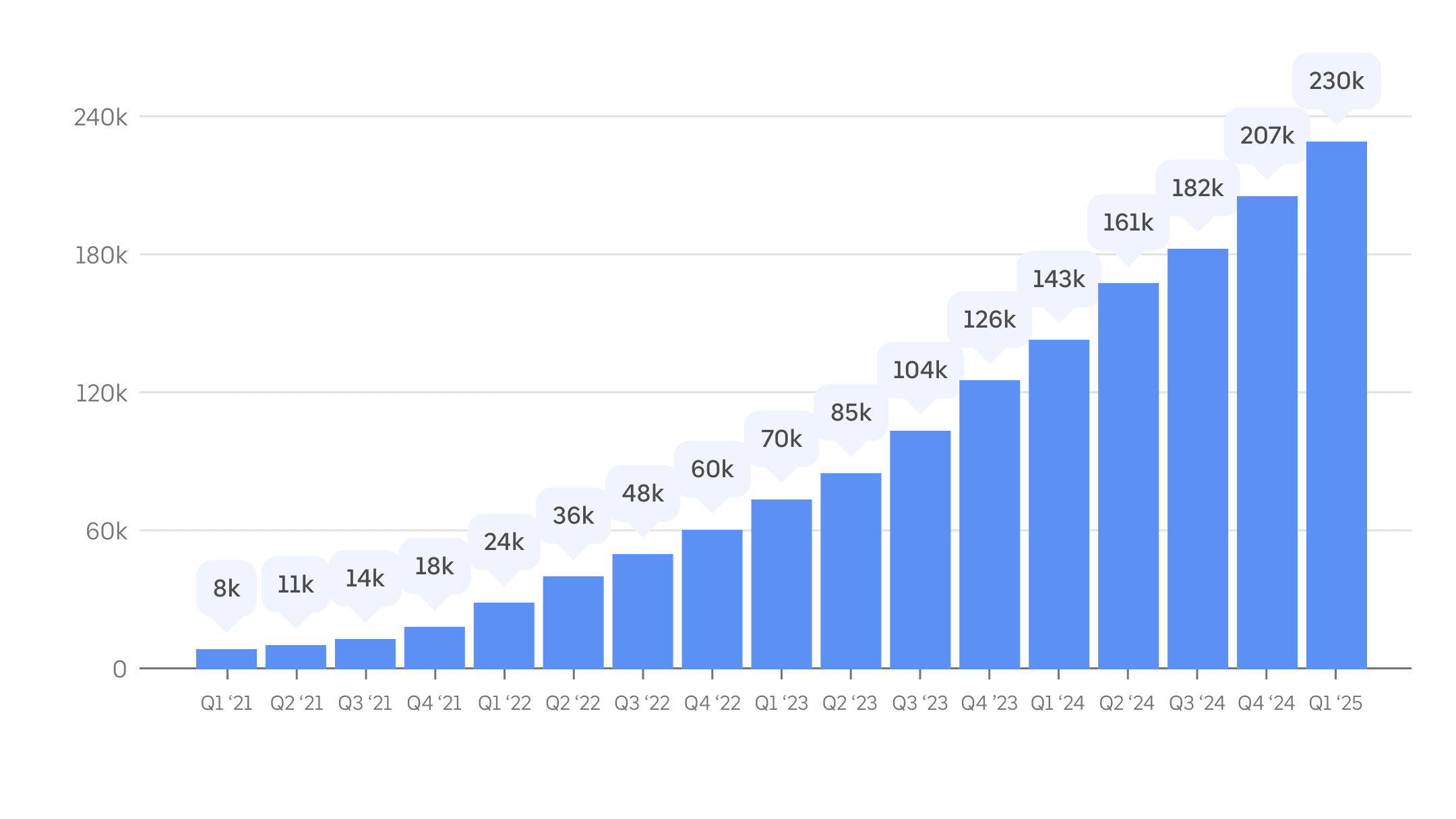
Metric: Average monthly active ZEV drivers on Uber, by quarter, since Q1 2021. Drivers using Uber’s app are counted as active in a given month if they’ve completed at least one trip in that calendar month.
Jízdy ZEV
In Q1 2025, ZEV drivers completed over 105 million tailpipe-emissions-free trips using Uber, globally—over 60% more than the number of ZEV trips completed on Uber during the same period a year earlier. That’s more than 13 ZEV trips on Uber every second, on average.
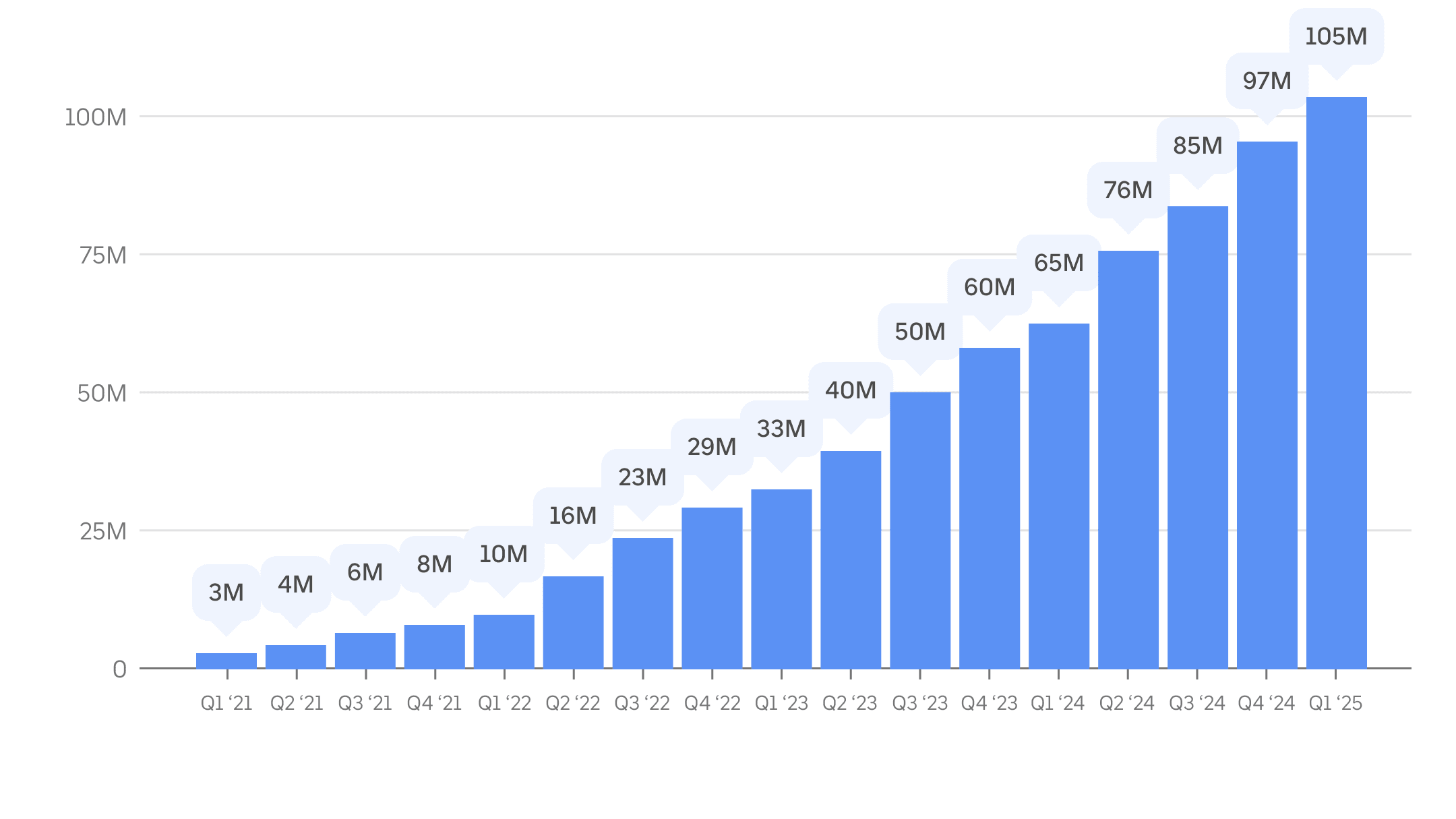
Statistika: Počet jízd objednaných přes aplikaci Uber a odřízených řidiči ZEV podle jednotlivých čtvrtletí od 1. čtvrtletí roku 2021.
Přijetí ZEV
In Q1 2025, ZEV drivers completed 15.3% of all on-trip miles in Europe and 9.1% of all on-trip miles in Canada and the US—adoption levels many times above drivers in the general public. Figures published in a 2024 BloombergNEF report show that ZEV uptake by Uber drivers in Europe was about 5 times faster than that of typical motorists.
Over the last 4 years, the average annual increase in all-electric on-trip mileage share on Uber in Europe and in the US and Canada was 3.1 and 2.2 percentage points, respectively. The highest and lowest annual increases recorded over that period occurred in the last year: since Q1 2024, ZEV uptake jumped more than 6 percentage points in Europe and just under 1 in the US and Canada.
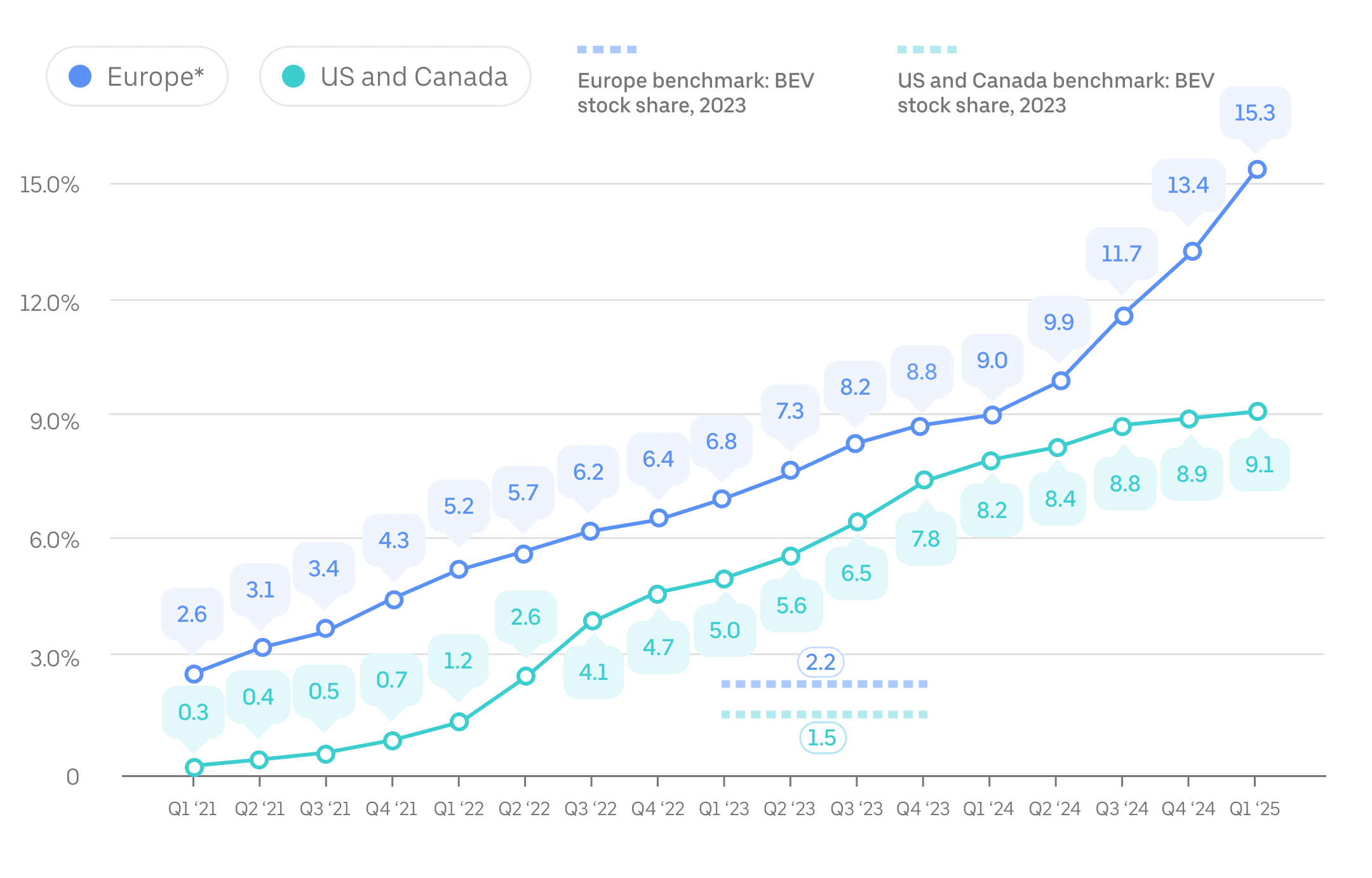
Metric: Share of on-trip miles completed in ZEVs compared with all on-trip miles arranged by the Uber app, by quarter since Q1 2021. Canada, US, and European benchmark data is as of 2023 (the most recently available at the time of this update) and is sourced from the International Energy Agency. “BEV” refers to battery electric vehicles.
Intenzita uhlíkových emisí cestujících
In 2024, each mile that a passenger traveled on Uber resulted in an average generation of 197 grams of CO₂ in Europe (or 123 grams of CO₂ per kilometer) and 340 grams of CO₂ in the US and Canada (or 212 grams of CO₂ per kilometer). Compared with 2021, this passenger carbon intensity metric fell nearly 14% in Europe and 6% across the US and Canada.
Passenger carbon intensity in Europe, the US, and Canada increased slightly between 2023 and 2024 due to minor decreases in average passenger occupancy and increases in “deadheading” (vehicle mileage incurred before and on the way to picking up passengers).
Metric: Passenger carbon intensity, or the estimated grams of CO₂ per passenger mile traveled, is an annual efficiency metric used by Uber—and, increasingly, governments and companies around the world. In the case of ridesharing, or any on-demand mobility service, emissions produced by any deadhead miles are factored into the calculation.
For more details about how we calculate passenger carbon intensity, go to our methodology document. Note that significantly lower average fuel economy for vehicles on Uber in Europe versus the US and Canada explains most of the difference in carbon intensity in these 2 geographies. While the composition of vehicles that drivers use on Uber’s app in Europe is more efficient (with a higher proportion of ZEVs and hybrids), more-stringent fuel economy reporting standards in the US also contributes to this discrepancy. In addition, we lack access to sufficient input data to calculate passenger carbon intensity for trips completed in European markets before 2021.
Statistiky a hluboké vhledy
EVs for everyone: balanced adoption of a maturing technology
Děláme udržitelnost lepší volbou (2024)
How to help spark electric mobility across Europe
Udržitelné trasování jízd k úsporám emisí (2023)
Proč se Uber zásadně liší od soukromých aut (2021)
Měření intenzity uhlíkových emisí dopravy (2019)
Časté dotazy
- What is in Uber’s Electrification Update?
Our Electrification Update provides interested stakeholders with performance-based metrics on carbon-related emissions and electrification for passenger vehicle trips enabled by the Uber app.
- Why are you publishing this update?
Down Small This update, based on real-world use of our mobility platform, helps provide greater transparency of our electrification impact and helps us improve our efforts to support efficiency on our platform.
- What are the key measurements you use in the Electrification Update?
Down Small Statistiky zahrnují následující údaje:
- Používání elektromobilů řidiči u Uberu (podíl mílí nebo kilometrů najetých v ZEV), které měří náš pokrok směrem k našemu cíli do roku 2040 globálně dosáhnout 100% bezemisní mobility
- Intenzitu uhlíkových emisí cestujících, která měří emise vzniklé při každé míli ujeté cestujícím
- How will this update improve emissions reduction and electrification uptake for rides on Uber?
Down Small We have bold ambitions to reduce the passenger carbon intensity of trips and increase the use of zero-emission vehicles on Uber. Measurement and transparency of the progress are important steps along our journey.
- Dávají cestující přednost jízdám Uberem namísto jízdám auty s nižšími emisemi uhlíku, jako je hromadná doprava?
Down Small Jízdy přes aplikaci Uber jsou jednou z mnoha možností dopravy pro lidi, kteří hledají svezení. Dostupné typy svezení hodně závisí na různých podmínkách na místním trhu. Naše analýza dat z průzkumu US National Household Travel Survey ukazují, že vyšší využívání nejudržitelnějších způsobů dopravy na domácnost (veřejná doprava, chůze a jízda na kole) souvisí s vyšším využíváním spolujízdy a dalších řešení na vyžádání.
- Budete měřit stejná data v ostatních zemích nebo oblastech po celém světě?
Down Small Many of the above metrics now cover all passenger trips completed with the Uber app globally. We’re aligned to regular reporting on carbon emissions and other impact areas resulting from trips on Uber.
- With what frequency do you expect to provide Uber’s Electrification Update?
Down Small We update metrics at least annually and may update some metrics more frequently. We’ll release emissions metrics (like passenger carbon intensity) annually, aggregated by calendar year.
- Co se myslí „vozidlem s nulovými emisemi“?
Down Small Pojem „vozidlo s nulovými emisemi“ (zero-emission vehicle, ZEV) používáme stejně jako California Air Resources Board (CARB) a Evropská federace pro dopravu a životní prostředí (T&E) pro vozidla s pohonem, který přímo nevytváří emise CO₂ ani jiné škodlivé látky znečišťující ovzduší (jako jsou NOx, pevné částice, CO₂ a SOx). Čtenář by měl podle svého uvážení zvážit místní slova.
Řidiči, kteří používají aplikaci Uber, dnes jezdí dvěma typy ZEV: elektrickými auty na baterie (bateriovými elektromobily) a velmi výjimečně elektrickými auty na vodíkový pohon (FCEV).
Slovem „nulové“ se u ZEV samozřejmě myslí nulové emise z „výfuku“ auta, a ne nutně všechny emise, které můžou vzniknout v období od výroby po likvidaci auta a jeho zdroje energie. Když ale vezmeme v potaz veškeré emise, analýzy životního cyklu od nezávislých odborníků ukazují, že „emise za dobu životnosti průměrných dnes registrovaných středně velkých bateriových elektromobilů jsou už teď o 66–69 % nižší než u srovnatelných benzínových aut v Evropě, o 60–68 % ve Spojených státech, o 37–45 % v Číně a o 19–34 % v Indii.“
- Will you measure impact for your Delivery business?
Down Small Our Electrification Update currently covers electrification and emissions metrics only for our Mobility business (ridesharing). We aim to include our progress on delivery emissions and electrification in future.
On packaging, Uber continues to invest in helping merchants transition to sustainable options. However, as with electrification, progress depends on collective action. We’re prioritizing efforts in cities where public and private investments are aligned. For example, in France over 60% of packaging used on the platform is recyclable, reusable, or compostable, supported by national policy and local incentives.
While progress has been made, based on current trends, we cannot meet all 2025 goals, and our 2030 goals will be out of reach without stronger, coordinated action across government and industry.
While many key levers are outside our control, we remain deeply committed to this transition. To learn more about Uber’s approach to more sustainable packaging with merchants, consult our Uber Eats for Merchants web page.
- Zveřejňuje Uber emise rozsahu 1, 2 a 3 a pokud ano, kde najdu příslušné údaje?
Down Small Uber discloses Scope 1, 2, and 3 emissions to CDP. You can find our most recent score in CDP’s public corporate score search. These emissions estimates have received limited assurance from an independent third party.
Na téhle stránce a v související zprávě o vlivu na klima a udržitelnosti a zprávě o životním prostředí, sociálních oblastech a řízení (dál jen „zprávy“) představujeme naše plány a cíle do budoucna, které se ale pojí s riziky a nejistotami. Skutečné výsledky se totiž od těch očekávaných můžou výrazně lišit. Další informace najdeš v našich zprávách.
Některé údaje zveřejněné v téhle zprávě získaly omezené ověření od LRQA. Ověřovací prohlášení LRQA najdeš tady.
Přehled toho, jak Uber používá uhlíkové kompenzace, najdeš tady.
Termíny, jako jsou „řidiči“, „kurýři“, „vydělávat“, „auto s nulovými emisemi“ nebo „udržitelné obaly“, jsou v téhle zprávě používány obecně a řídí se obecným příkladem použití slov Uber Technologies, Inc. Čtenář by měl podle svého uvážení zvážit místní variace slov.
Informace
